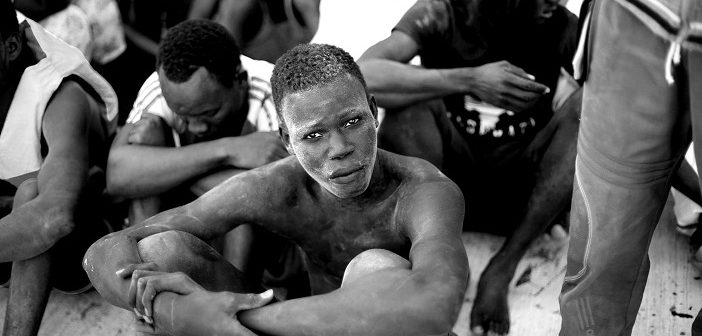Containing illegal migration is currently and in the foreseeable future the most important challenge for Europe.
Of particular importance is the central Mediterranean route from Libya to Italy. In August 2017, the numbers of migrants arriving in Italy has dropped from 21.294 (August 2016) to 3.920 for various reasons, including some kind of an Italian arrangement with militias involved in human trafficking in the main site of embarkation, Sabratha.
Although after the defeat of those militias on the hands of their local rivals the numbers increased again in September, they remained at about 6,000 per month.
These figures are still significantly lower than in 2016.
* * *
The main reasons for this are a better equipped and more efficient Libyan Coast Guard, benefitting allegedly from radar data provided by the Italian Navy, a more difficult situation for the human trafficker networks ashore and the absence of most of the NGO ships off the Libyan coast. The latter makes the trip much more difficult to organize and much riskier, in particular during the bad weather season. As documented by human rights organizations, the situation of the migrants stuck in Libya is very difficult. Although there are NGOs and Libyans doing their best to care for the migrants, the circumstances in the camps and detention centres are dire. Human rights violations are frequent.
It can be expected that as soon as the weather gets better next year, the numbers of migrants reaching Italy will increase again, albeit probably not to the levels before summer 2017.
However, it is really a matter of urgency for Europe to find lasting solutions for the migration problem. Actually, a two-step approach is required: a “stop-gap plan” to deal with the imminent crisis and a mid-term strategy to work on the root causes of migration.
The “stop-gap plan”
The objective of the “stop-gap plan” is to prevent the migrants from illegally reaching mainland Europe by conducting an organized immigration process beforehand.
Consequently, migrants picked up off the Libyan coast by Operation Sophia, Frontex, and the various NGOs must be transported to an Italian or a Greek island. Maybe it would be also possible to lease a Tunisian island for this purpose. Eventually, other migrants apprehended without permission to stay in Italy (or Greece) could be also moved there.
On these islands migration centres for at least 10,000 persons with proper living standards must be established, in accordance with the UNHCR standards and financed by the EU. The selected locations should be preferably uninhabited. But if no such suitable islands can be found, a (very good) deal with the local population is required to get their agreement for the centres, at least on a temporary basis for a couple of years. The islands must not be directly in front of the mainland, to make it more difficult for criminal gangs to smuggle migrants from the camp to the mainland.
Establishing the migration centre in Sicily or mainland Italy/Greece would not be a good idea. This would require a high and very stable fence with barbed wire surrounding the camp, which would give the negative impression of a prison. Criminal gangs would try to get the migrants out of the camps and smuggle them further on to their desired destinations.
Furthermore, from a psychological point of view, it would probably be more difficult to repatriate migrants who have the perception that they already made it to Europe.
At the migration centres the country of origin and the hometown of the migrants must be identified. This can easily be achieved by using tools like Google Earth. The migrant must provide his “home address” and needs to describe the surroundings, while an immigration officer checks this information on Google Earth and asks further questions.
Depending on the outcome of this first “screening” the asylum procedure takes place. This should be either conducted by Italy/Greece or by personnel from the other EU countries in accordance with their respective agreed quota. Thereafter the distribution to the countries of asylum takes place for the positive cases – or the repatriation to the home countries for the negative cases.
A precondition for the repatriation are agreements with the countries of origin. Unfortunately, those are frequently difficult to achieve. In the negotiations, which should be conducted by the EU, a carrot and stick approach is required. The “carrots” comprise a legal immigration process with certain quotas and tailored development programs. As most of those countries in question are heavily dependent on international funding and development aid, threatening to freeze these sources of money is the best “stick”.
This “stop-gap plan” must not be mixed up with Australia’s “Pacific Solution”. The island Nauru is about 4,500 km away from Australia in the Pacific, while those EU migration centres would be right on the border of Europe. The migrants in Nauru have no chance to get asylum in Australia and the living conditions are difficult. It would be the responsibility of the EU-parliament and the civil society to control and ensure proper standards in the European camps.
The expected result of the “stop-gap plan” is a humane and correct process to decide about the right of the migrants rescued from the sea to immigrate into Europe and to establish a way of legal immigration directly from the countries of origin. Within months, potential immigrants will realize in their home countries that the dangerous trip through Libya and over the Mediterranean does not lead to the desired result. It can be expected that the numbers trying to immigrate illegally will drop significantly.
However, the “stop-gap plan” is no long-term solution for the problem. Such a solution must be found in the countries of origin.
The root causes for migration and multipliers
Social, economic, and security factors in combination with a very difficult human rights situation are frequently the root causes for the decision to migrate.
Demographic developments, governance, and environmental problems are multipliers, worsening the already difficult conditions.
A phased 3-layered mid-term strategy
A strategy dealing with all the complex issues must be multi-layered and start with the “multipliers”.
Layer 1: containing the “multipliers”. Layer 2: achieving a broad impact. Layer 3: narrowing the gap to the developed world.
The objectives of layer 1 are to limit the population growth, achieve progress on environmental protection and improve good governance.
There is absolutely no way to contain the migration wave, if the demographic developments materialize as currently expected. The provision of social security, establishing basic health standards to reduce infant mortality and changing the role of women in society are paramount to limit the growth. Environmental pollution needs to be reduced by facilitating public transportation, improving waste management, and waste water treatment. A further decrease of agricultural cultivation areas must be avoided. Water security is of critical importance.
Without energy a modern development is impossible. Africa’s vast opportunities for Green Energy should be exploited. Promoting good governance and ethics, as well as fighting corruption are together with reducing bureaucracy and rising efficiency needs to be the focus of the training of the administration.
In layer 2 the objectives are to implement the most urgent measures for stabilization and to deal with the key problems in the social, economic, security and human rights sector.
The basic idea is to use the – always limited – resources for projects aiming to achieve a broad positive and visible impact for the population. Their social situation must be improved by the provision of basic supplies, better general health standards, and basic education. Job creation needs to focus on the many people with relatively low qualifications, in particular on the creation of infrastructure of all kinds. A better trade and logistics infrastructure should make the countries more attractive for foreign investments. Agricultural improvements have the aim to enlarge the fertile land, better irrigation, and the creation of additional jobs. An “industrialization” of farming to achieve food self-sufficiency would be a mistake, as this would be a “job-killer”.
Security forces training must concentrate on officers and non-commissioned officers training, and include the communication of modern values and human rights. Respect for the latter is first and foremost a matter of mindset, but the training of formal and informal leaders, proper laws and international supervision can certainly support compliance. In layer 2 adherence to some basic standards should be achieved.
In some crisis areas it will be necessary to establish UN-administered “Refugee Safety Zones” (RSZ) to allow the local population to stay within their own countries or right over the border. Those zones are not just another refugee camp; they must be constructed and organized like new (temporary) cities. Furthermore, RSZs should offer organized proceedings for people seeking asylum in other countries. Organized migration procedures should also lower the probability of terrorist infiltration into Europe.
The objectives of layer 3 are to achieve a consolidation and significant improvement in the sectors mentioned above. Although a broad effect is most important for the success of the strategy, at the given time it is essential to shift the focus to “peak performance”. This layer includes tertiary health care, universities, and the establishment of a modern economy.
The main focus of the strategy is for an initial period on the first layer, as a success there will make work on the second layer much easier. Achievements on the second layer are a precondition for the third layer. However, even when priority has shifted from the first to the second and later on to the third layer, efforts must continue on the previous layers to achieve a lasting success.
Funding
The strategy should be funded by those who have a particular interest in the stabilization of the migrant situation and in a consolidation of Africa.
This includes not only Europe and the international financial institutions, but also the wealthy Arab States from the Gulf region. Furthermore, the United States and the East Asian countries interested in Africa’s resources should also take their share.
Anyhow, there will never ever be enough funding to implement the strategy everywhere. In order to achieve the desired impact, it will be necessary to decide the priorities.
Practical diplomacy is required, not a scattergun approach. Fortunately, it is not necessary for every country to start at layer 1. Some countries, like Tunisia, are well advanced. On the other side, several, like South Sudan, are far behind.
* * *
If Europe wants to contain the flow of migrants and survive in the long run, it will be necessary to come together and face the challenge at its roots now.
Coordination and leading nations are required. The more time is wasted, the more challenging it will be…




1 Comment
I understand your frustration you do not want africans in your land or anywhere in Europe, have you ever thought or has it occurred to you that if your country and other europeans countries should stop interfering in Africa stop colonising it collecting all its resources, installing puppet/dictatorial gov. so that they will serve you but will not serve its own people who are dying from starvation because your greediness and white supremacist is over any humanity law. If you stop all that then the Africans wouldn’t want to leave their country but you have made it impossible to survive in their own country as a last example Libya. So instead of suggesting such nonsense take responsibility over your gov actions & either accept it or fight your gov. to stop invading sovereign countries and for once work your own land to get rich oh I forgot you want the African resources to keep warm in winter and their diamonds to give to your white girlfriends and you need the uranium to built bombs. So my suggestion accept the fact that from the moment you wanted a regime change in Libya all Africans will come to Europe. Qaddafi told you that & you thought he was joking so now lump it… and stop complaining.